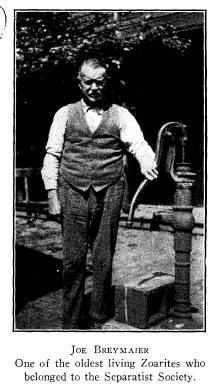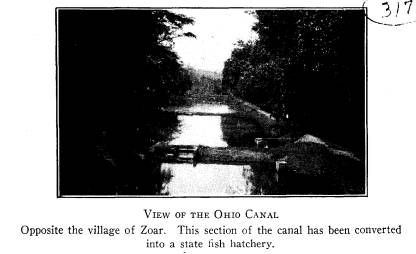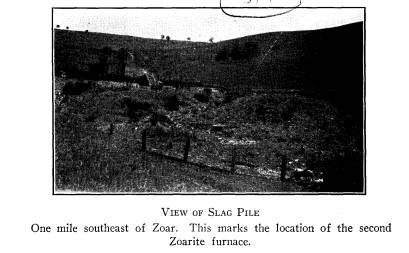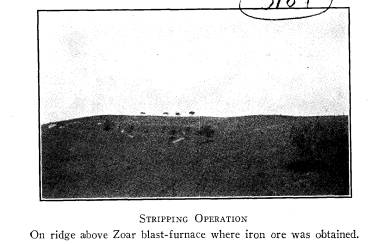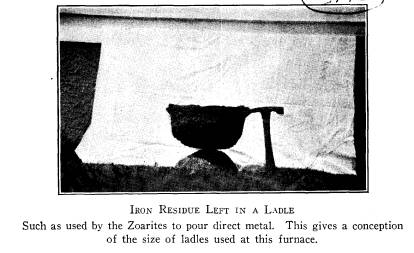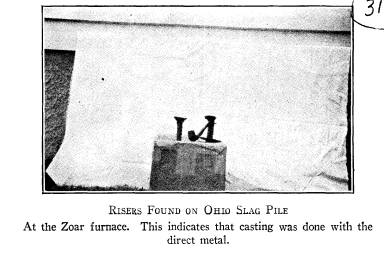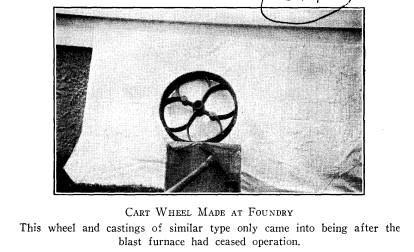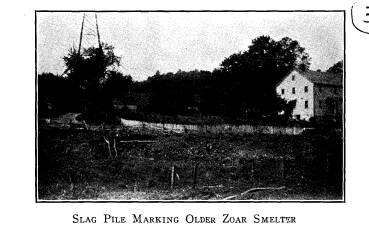Ohio History Journal
BLAST-FURNACES OPERATED BY THE
SEPARATIST SOCIETY OF ZOAR,
OHIO
BY E. J. BOGNAR
A most important contribution to the
success of the
Separatist Society of Zoar was iron
ore. The village
of Zoar was founded in 1817 by 300 or
more Sepa-
ratists who had embarked early that
spring from
Wurtemburg,1 Germany. The party was led
by one
Joseph M. Bimeler2 and the desire for
religious free-
dom brought them to this country where
they settled in
the inviting wooded region of the
Tuscarawas Valley.
Since the people had little or no money
and few
worldly possessions it was quite
necessary for them to
manufacture most of the things they
needed. The party
that settled here fortunately counted
in their ranks
learned craftsmen of various kinds.
Being of German
stock, they had mastered their trades
with characteristic
Teutonic thoroughness. Consequently we
find that
these people made everything that they
needed, such
as wearing apparel, machinery,
household goods, ve-
hicles and other necessaries of life. At
the height of
its prosperity the Society boasted some
12,000 acres, a
tannery, flour-mill, lime-kiln,
foundry, woolen-mill, ma-
1 Ohio Archaeological and Historical
Quarterly, Vol. VIII, July, 1899.
2 Originally Baumler, which name was
later changed to Bimeler, and
is so known today in Zoar and
elsewhere.--Ed.
(503)
|
504 Ohio Arch. and Hist. Society Publications chine shop, blacksmith shop, planing-mill, brick-yard, dairy, brewery, and bakery. Toward the end of the communistic regime even a powerhouse was claimed by the people. In fact, about the year 1883, the prosperity |
|
|
of this village was so pronounced that it drew tradesmen from Akron, which place according to Jacob Singer, was not nearly as thriving a vil- lage. The Separatists did not come here to set up a com- munistic form of govern- ment, but finding them- selves composed of young children, old people, and the able-bodied, they de- cided to band together and work for a common good. They chose as their head Joseph M. Bimeler, who proved to be a very able leader and business man. Hence, as soon as possible, |
|
the people were classified and placed where Bimeler thought they would do the most good. Some worked in the fields, others in the tannery, some in the woolen mill, etc. Each one had a certain task allotted to his or her special care. The crops were stored in large barns and the cattle kept in a large general building. All the bread was baked in the village bakery and carried around to |
|
Society of Zoar Blast-Furnaces 505 the individual homes. The beer-wagon passed around twice daily and the households could have all that they wanted. Several families commonly lived in a home and all ate well, lived simple lives, had few worries and were contented. Money there was none. Nothing be- longed to an individual but everything to the Society as a whole. From the foregoing one readily gathers that con- siderable iron was needed by the Zoarites. Inasmuch |
|
|
|
as iron ore abounded in the hillsides and was rather easy to procure, they conceived the idea of manufactur- ing their own pig iron. This leads us to our main topic, namely the blast-furnaces of Zoar. The writer has devoted considerable of his time to the study of the village of Zoar and found the problem of obtaining the past history of the Society a most difficult task, even though it disbanded as late as 1899. The greater por- tion of the members of the Separatist Society left Zoar |
|
506 Ohio Arch. and Hist. Society Publications and now but few remain. Joseph Breymaier,3 aged 69 years, is one of the oldest members left in the commu- nity. He tells us that the slag piles, the mute testimony left where the furnaces once stood, looked the same in 1869 as they do now. At that time he was nine years of age. In other words these furnaces ceased operat- ing before he was born. Mrs. Beiter, aged 82, who is the oldest living Zoarite, states that the slag pile at the |
|
|
|
Zoar furnace as far back as she can remember, has al- ways looked practically as it does now. This evidence, then, places the cessation of the furnace at no later date than 1847. There are no records of when they commenced, where the pig iron was shipped, or what the daily production was. No one even knows when the works ceased. We have appealed to the Department of Public Works of Ohio and have personally perused 3 One of the oldest living Zoarites that belonged to the Separatist So- ciety. He served as one of the three directors on the last board in 1898. |
|
Society of Zoar Blast-Furnaces 507 their early records, and all to no avail. It seems, there- fore, that the history of these most interesting furnaces has been entirely forgotten, even though they doubtless played a very important part in the life of the Sepa- ratist Society. The Ohio Canal, which was started in 1825, was open for navigation in this locality early in 1828. This event no doubt spurred the Zoarites on to take advan- |
|
|
|
tage of the opportunity and ship their surplus. It is very likely that the second furnace, which is located one mile southwest of Zoar on the Renner farm, was built and operated for the sole purpose of shipping pig iron on the canal. The furnace site is too far from Zoar (about 6 miles) and its production of such proportion that it was out of the question to consider that the Sepa- ratists consumed its output. It was operated by the Society merely as a commercial enterprise and rewarded them handsomely for their efforts. Plate No. 3 shows |
508
Ohio Arch. and Hist. Society Publications
the blast-furnace slag pile, only half
of which remains,
the rest having been used for road
ballast. Plate No.
4 is a view of the diggings where iron
ore was obtained
by stripping. The trench is at least
half a mile long and
thousands of tons of over burden were
removed here.
The ore occurs in nodular form and is
associated with the
Upper Freeport Limestone of the
Allegheny formation.
A large fourteen room community dwelling-house
stood
near the furnace where lived the men
who operated the
furnace and the diggings. It seems that
teams were
used wherever possible and that only
the selection of
the uncovered ore was done by hand. The
furnace was
located at the base of the ridge shown
in Plate No. 4,
hence it was quite simple to bring the
ore to the furnace.
The furnace in turn was only about a
quarter of a mile
from the Ohio Canal. The approach
furthermore was
made easy as the wagons loaded with the
pigs descended,
by way of a gently sloping, rather wide
valley, to the
barges.
A careful scrutiny of the slag pile
rewarded the au-
thor with risers, pieces of pig iron,
bits of the limestone
flux, and revealed the fact that
charcoal was the fuel
used in the smelting of the ore. The
lining was com-
posed essentially of ganister obtained
locally in large
quantities. A very poor grade of
fire-brick was also
used. These were made of a low
refractory plastic
clay with a considerable proportion of
sand and large
particles of grog. Specimens of the
ganister and the
brick with slag adhering are in the
writer's possession.
The ganister seems to have been very
effective in re-
sisting the fluxing of the metal and
the slag.
The size of the furnace cannot be
determined as
|
Society of Zoar Blast-Furnaces 509 everything has been destroyed. Judging from the slag pile and the ore diggings, at least several thousand tons of pig iron must have been produced. The older of the two Zoarite furnaces is located on the slag road that joins Bolivar and Zoar and which passes the Imperial Fire-Brick Company and the fish hatcheries. It is about one and one-half miles north- west of the village and (essentially) on the banks of the Ohio Canal. A short spur from the main canal runs |
|
|
|
up to the site of the furnace. It is evident that from this iron furnace pits and possibly castings, were ex- ported. We have reason to believe, though, that it was this operation that supplied the needs of the commu- nity and that only the excess production was shipped away. Also it is our candid opinion that this furnace was built and put into production before the Canal, or about in 1820. Our reason for this is that the three hundred settlers had very few implements with them |
510
Ohio Arch. and Hist. Society Publications
and in order to survive they needed
nails, latches,
hinges, and such like, so it seems very
possible that the
furnace was founded even before 1820.
Later records
show that the community became famous
for its large
heating stoves, plowshares and
machinery. The iron
for all of these, we are certain, was
melted by this
furnace.
At this furnace site we found evidence
as shown in
Plate No. 5 that castings, probably
stoves, were made
of the direct molten iron with further
refining. The
ladles used are estimated to have held
several hundred
pounds of melt. Five of these ladle
bottoms were found
here. The risers (in Plate No. 6) which
were found
in the slag pile are also evidence that
casting was done.
Here, as at the Zoarville furnace just
described, ganis-
ter and a poor grade of fire-brick made
up the lining.
The fuel was charcoal and the flux the
Lower Mercer
limestone. The latter was obtained near
at hand, as
the stone outcrops near the stream
level of the Tusca-
rawas River. Later this stone was
exported in large
quantities to Dover where it was also
used as a blast-
furnace flux.
The ore used here was probably of two
different
grades. First, the kidney ore obtained
at the Upper
Mercer level was used. Perhaps the kind
more com-
monly smelted was that obtained in the
shale between
the No. 5 and the 5-A coals. Numerous
diggings scat-
tered about the hillside were found at
both horizons.
As the pits on the upper level are the
larger and by far
the more common, we believe most of the
ore to have
been mined at this level. None of the
mining was un-
derground, all being dug out of shallow
pits. Both
|
Society of Zoar Blast-Furnaces 511 ores used are of the kidney variety, the average iron content being between 28 and 34 per cent. The ore beds are not rich near this furnace and for this reason, only the easily obtained iron nodules were dug. This accounts for the numerous pits of varying size to be found in the adjoining hillsides. The Upper Freeport horizon does not exist here and only makes its appear.- |
|
|
|
ance several miles to the southeast. It was probably after the obtaining of ore had become a problem that the Zoarites discovered the richer horizon at Zoarville. They no doubt decided it was much easier to build a furnace and do the smelting there than to transport the ore to the Zoar furnace. This leads us to believe that the Zoarville furnace was the larger and more sys- tematically operated of the two. Plate No. 7 displays a cast iron wheel which no doubt was made in their foundry. This, however, only |
|
512 Ohio Arch. and Hist. Society Publications came into being some time after 1870, as the old resi- dents remember about this. These furnaces ceased operation shortly after the advent of the Lake Superior iron or three-quarters of a century ago. The Separatists were wise people and when they surmised that they could not compete with iron made from Lake Superior ore, they abandoned their operations, built a foundry and bought pig iron. |
|
|
|
The dissolution of the Separatist Society of Zoar was brought about by events just such as this. In 1899 they finally realized that they could no longer successfully compete with the industries outside their community. There crept into the quiet settlement discontent caused by outside influences and the ever increasing influx of tourists and vacationists who came here in the summer months. The younger generation felt that they did not have the opportunity for advancement as did the youth of the outside world. They wanted money and a |
|
Society of Zoar Blast-Furnaces 513 division of property. In other words they were dis- satisfied with the communistic form of government which had worked so well for their fathers and grand- fathers. The disbanding came in 1899 and today the community is a mere shadow of its former self. The population is about 250; most of the old settlers have departed and antique-hunters have stripped the place |
|
|
|
of the old home-made things. So well has this been accomplished that it is with difficulty one finds genuine things made by the Zoarites. The old villagers seem to place little value on the things left by their parents. Practically anything still remaining can be purchased. What seems the worst of all is that very few records are available. Those that were kept have become scat- tered and this together with the fact that only a few old Separatists survive, makes it exceedingly difficult to gather reliable information about the most successful and longest-lived communistic society in America. Vol. XXXIX--33. |
